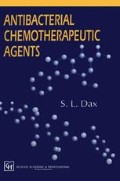Abstract
The discovery and development of the sulfonamide antibacterial agents in many ways ushered in the modern era of antibacterial chemotherapy. The preceding decades were rich in advances in chemical technology (i.e. synthesis) and in the understanding of many disease processes. At the turn of the century, infectious disease research was evolving from a passive study based primarily upon the power of observation, to a science in which bacterial species could be identified, cultured and examined. The fundamental processes of pathogenesis were recognized and could even be anticipated in some instances. However, prior to the pioneering work of Paul Ehrlich, scientists were essentially incapable of conceiving and designing biologically active substances. Most often chance prevailed and significant advances were slow to come.
Access this chapter
Tax calculation will be finalised at checkout
Purchases are for personal use only
Preview
Unable to display preview. Download preview PDF.
Further reading
N. Anand(1975) ‘Sulfonamides and sulfones’ in Antibiotics III (Mechanism of Action of Antimicrobial and Antitumor Agents) J.W. Concoran and F.E. Hahn (Eds), Springer-Verlag, New York, pp. 668–698.
J.J.Burchall(1975) ‘Trimethoprim and pyrimethamine’ in Antibiotics III (Mechanism of Action of Antimicrobial and Antitumor Agents) J.W. Concoran and F.E. Hahn (Eds), Springer-Verlag, New York, pp. 304–320.
F.M. Sirotnak, J.J. Burchall, W.B. Erisminger and J.A. Montgomery (Eds) (1984)Folate Antagonists as Therapeutic Agents; Vol. I Biochemistry, Molecular Actions and Synthetic Design Academic Press, Orlando, FL.
G.H. Hitching (Ed.) (1983) ‘Inhibition of folate metabolism in chemotherapy, the origins and uses of co-trimoxazole’,Handbook of Experimental Pharmacology Vol. 64, Springer-Verlag, Germany.
E.H. Northey (1948)The Sulfonamides and Allied Compounds American Chemical Society Monograph Series, Reinhold, New York.
J.K. Seydel (1968) ‘Sulfonamides, Structure-Activity Relationship, and Mode of Action’,J.Pharm. Sei.571455.
M. Kansy, J.K. Seydel, M. Wiese and R. Haller (1992) ‘Synthesis of new 2,4—diamino—5—benzylpyrimidines active against bacterial species’,Eur. J. Med. Chem.27 237.
J.H. Chan and B. Roth (1991) ‘2,4-Diamino-5-benzylpyrimidines as antibacterial agents. 14. 2,3—Dihydro—l—(2,4—diamino—5—pyrimidyl)-lH-indenes as conformationally restricted analogues of trimethoprim’,J. Med. Chem.34 550.
J.J. Burchall, L.P. Elwell and M.E. Fling (1982) ‘Molecular Mechanisms of Resistance to Trimethoprim’,Rev. Infectious Diseases 4 246.
P. Huovinen (1989) ‘Trimethoprim Resistance’,Antimicrob. Agents Chemother.31 1451.
M.L, Pato and G.M. Brown (1963) ‘Mechanisms of resistance ofEscherichia colito Sulfonamides’,Arch. Biochem. Biophys.103443.
P.J. Ortiz (1970) ‘Dihydrofolate and dihydropteroate synthesis by partially purified enzymes from wild-type and sulfonamide-resistant pneumococcus’,Biochemistry 9 355.
P.J. White and D.D. Woods (1965) ‘The synthesis of p-aminobenzoic acid and folic acid by staphyl sensitive and resistant to sulphonamides’,J. Gen. Microbiol.40 255.
B. Wolf and R.D. Hotchkiss (1963) ‘Genetically modified folic acid synthesizing enzymes of Pneumococcus’,Biochemistry 2, 145–150.
E.M. Wise, Jr. and M.M. Abou-Donia (1975) ‘Sulfonamide resistance mechanism inEscherichia coli: R plasmids can determine sulfonamide-resistant dihydropteroate synthases’,Proc. Natl. Acad. Sei. USA 722621.
G. Swedberg, S. Castensson and O. Skold (1979) ‘Characterization of mutationally altered dihydropteroate synthase and its ability to form a sulfonamide-containing dihydrofolate analog’,J. Bacteriol 137 129.
O. Skold (1976) ‘R—factor—mediated resistance to sulfonamides by a plasmid-borne, drug-resistant dihydropteroate synthase’,Antimicrobial Agents Chemother.9 49.
L. Bock, G.H. Miller, K.-J. Schaper and J.K. Seydel (1974) ‘Sulfonamide structure-activity relationships in a cell-free system. 2. Proof for the formation of a sulfonamide-containing folate analog’,J. Med. Chem.1723.
G.E. Dale, R.L. Then and D. Stuber (1993) Characterization of the Gene for Chromosomal Trimethopro Sensitive Dihydrofolate Reductase ofStaphylococcus aureusATCC, 25923,Antimicrobial Agents Chemother.371400–1405.
K.H. Mayer, M.E. Fling, J.D. Hopkins and T.F. O’Brien (1985) ‘Trimethoprim resistance in multiple genera of enterobacteriaceae at a US hospital: spread of type II dihydrofolate reductase gene by a single plasmid’,J. Infectious Diseases 151783.
L. Sundstrom, T. Vinayagamoorthy and O. Skold (1987) ‘Novel type of plasmid-borne resistance to trimethoprim’,Antimicrobial Agents Chemother.31 60.
R. Steen and O. Skold (1985) ‘Plasmid-borne or chromosomally mediated resistance by Tn7 is the most common response to ubiquitous use of trimethoprim’,Antimicrobial Agents Chemother.27933–937.
Author information
Authors and Affiliations
Rights and permissions
Copyright information
© 1997 Chapman & Hall
About this chapter
Cite this chapter
Dax, S.L. (1997). Sulfa antibacterials and arylpyrimidine antifolates. In: Antibacterial Chemotherapeutic Agents. Springer, Dordrecht. https://doi.org/10.1007/978-94-009-0097-4_2
Download citation
DOI: https://doi.org/10.1007/978-94-009-0097-4_2
Publisher Name: Springer, Dordrecht
Print ISBN: 978-94-010-6531-3
Online ISBN: 978-94-009-0097-4
eBook Packages: Springer Book Archive

